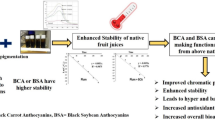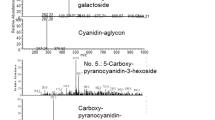Abstract
This study investigated the compositions of anthocyanins in blackberry juice and the effect of heating (70, 80, and 90 °C) on individual anthocyanins, as well as its impact on antioxidant activity. The results showed that five anthocyanins were identified, including cyanidin (Cy)-3-O-glucoside (1), Cy-3-O-arabinoside (2), Cy-3-O-malonyl-glucoside (3), Cy-3-O-dioxalyl-glucoside (4), and the Cy derivative (5). The degradation rates of individual anthocyanins (1–4) followed the first-order reaction kinetics. Unexpectedly, the amount of the Cy derivative (5) was observed to slightly increase in temperature. At the same temperature, the half-lives (T 1/2) values of each anthocyanin (1–4) significantly differed (P < 0.05). Maximum of the T 1/2 values were observed with Cy-3-O-dioxalyl-glucoside (T 1/2 values ranged 9.48–3.54 h) and exhibited relatively resistant stability. Moreover, the T 1/2 values of Cy-3-O-glucoside were higher than Cy-3-O-arabinoside and Cy-3-O-malonyl-glucoside. The antioxidant activity of blackberry juice reduced with the decreasing of total anthocyanins. These results demonstrated that the time dependency of anthocyanins degradation and antioxidant capacity were strongly correlated in blackberry juice.



Similar content being viewed by others
References
Catherine Felgines OT, Besson C, Fraisse D, Lamaison J-L, Rémésy C (2002) Blackberry anthocyanins are slightly bioavailable in rats the American Society for Nutritional Sciences. J Nutr 132(1249–1253):2002
Tate P, Kuzmar A, Smith SW, Wedge DE, Larcom LL (2003) Comparative effects of eight varieties of blackberry on mutagenesis. Nutr Res 23(7):971–979
Tate P, Stanner A, Shields K, Smith S, Larcom L (2006) Blackberry extracts inhibit UV-induced mutagenesis in Salmonella typhimurium TA100. Nutr Res 26(2):100–104. doi:10.1016/j.nutres.2005.11.005
Bowen-Forbes CS, Zhang Y, Nair MG (2010) Anthocyanin content, antioxidant, anti-inflammatory and anticancer properties of blackberry and raspberry fruits. J Food Compos Anal 23(6):554–560
Dai J, Gupte A, Gates L, Mumper RJ (2009) A comprehensive study of anthocyanin-containing extracts from selected blackberry cultivars: extraction methods, stability, anticancer properties and mechanisms. Food Chem Toxicol 47(4):837–847
Seeram NP, Adams LS, Zhang Y, Lee R, Sand D, Scheuller HS, Heber D (2006) Blackberry, black raspberry, blueberry, cranberry, red raspberry, and strawberry extracts inhibit growth and stimulate apoptosis of human cancer cells in vitro. J Agric Food Chem 54(25):9329–9339
Moyer RA, Hummer KE, Finn CE, Frei B, Wrolstad RE (2001) Anthocyanins, phenolics, and antioxidant capacity in diverse small fruits: Vaccinium, rubus, and ribes. J Agric Food Chem 50(3):519–525
Stintzing FC, Stintzing AS, Carle R, Wrolstad RE (2001) A novel zwitterionic anthocyanin from evergreen blackberry (Rubus laciniatus Willd.). J Agric Food Chem 50(2):396–399
Acosta-Montoya Ó, Vaillant F, Cozzano S, Mertz C, Pérez AM, Castro MV (2010) Phenolic content and antioxidant capacity of tropical highland blackberry (Rubus adenotrichus Schltdl.) during three edible maturity stages. Food Chem 119(4):1497–1501
Cavalcanti RN, Santos DT, Meireles MAA (2011) Non-thermal stabilization mechanisms of anthocyanins in model and food systems—an overview. Food Res Int 44(2):499–509
Yang Z, Han Y, Gu Z, Fan G, Chen Z (2008) Thermal degradation kinetics of aqueous anthocyanins and visual color of purple corn (Zea mays L.) cob. Innov Food Sci Emerg Technol 9(3):341–347
Stintzing FC, Conrad J, Klaiber I, Beifuss U, Carle R (2004) Structural investigations on betacyanin pigments by LC NMR and 2D NMR spectroscopy. Phytochemistry 65(4):415–422
Sadilova E, Stintzing FC, Carle R (2006) Thermal degradation of acylated and nonacylated anthocyanins. J Food Sci 71(8):C504–C512
Wang W-D, Xu S-Y (2007) Degradation kinetics of anthocyanins in blackberry juice and concentrate. J Food Eng 82(3):271–275
Wrolstad RE, Durst RW, Lee J (2005) Tracking color and pigment changes in anthocyanin products. Trends Food Sci Technol 16(9):423–428
Bondet V, Brand-Williams W, Berset C (1997) Kinetics and mechanisms of antioxidant activity using the DPPH. Free radical method. LWT—Food Sci Technol 30(6):609–615
Hanlon PR, Barnes DM (2011) Phytochemical composition and biological activity of 8 varieties of radish (Raphanus sativus L.) sprouts and mature taproots. J Food Sci 76(1):C185–C192
Stintzing FC, Trichterborn J, Carle R (2006) Characterisation of anthocyanin–betalain mixtures for food colouring by chromatic and HPLC–DAD-MS analyses. Food Chem 94(2):296–309
Tian Q, Giusti MM, Stoner GD, Schwartz SJ (2006) Characterization of a new anthocyanin in black raspberries (Rubus occidentalis) by liquid chromatography electrospray ionization tandem mass spectrometry. Food Chem 94(3):465–468
Fazaeli M, Yousefi S, Emam-Djomeh Z (2011) Investigation on the effects of microwave and conventional heating methods on the phytochemicals of pomegranate (Punica granatum L.) and black mulberry juices. Food Res Int. doi:10.1016/j.foodres.2011.03.043
Rubinskiene M, Viskelis P, Jasutiene I, Viskeliene R, Bobinas C (2005) Impact of various factors on the composition and stability of black currant anthocyanins. Food Res Int 38(8–9):867–871
Sadilova E, Stintzing FC, Kammerer DR, Carle R (2009) Matrix dependent impact of sugar and ascorbic acid addition on color and anthocyanin stability of black carrot, elderberry and strawberry single strength and from concentrate juices upon thermal treatment. Food Res Int 42(8):1023–1033
Nayak B, Berrios JDJ, Powers JR, Tang J, Ji Y (2011) Colored potatoes (Solanum tuberosum L.) dried for antioxidant-rich value-added foods. J Food Process Preserv 35(5):571–580
Seeram NP, Bourquin LD, Nair MG (2001) Degradation products of cyanidin glycosides from tart cherries and their bioactivities. J Agric Food Chem 49(10):4924–4929
Piffaut B, Kader F, Girardin M, Metche M (1994) Comparative degradation pathways of malvidin 3,5-diglucoside after enzymatic and thermal treatments. Food Chem 50(2):115–120
Adams JB (1973) Thermal degradation of anthocyanins with particular reference to the 3-glycosides of cyanidin. I. In acidified aqueous solution at 100 °C. J Sci Food Agric 24(7):747–762
Yue X, Xu Z (2008) Changes of anthocyanins, anthocyanidins, and antioxidant activity in bilberry extract during dry heating. J Food Sci 73(6):C494–C499
Yan X, Murphy BT, Hammond GB, Vinson JA, Neto CC (2002) Antioxidant activities and antitumor screening of extracts from cranberry fruit (Vaccinium macrocarpon). J Agric Food Chem 50(21):5844–5849
Miyazawa T, Nakagawa K, Kudo M, Muraishi K, Someya K (1999) Direct intestinal absorption of red fruit anthocyanins, cyanidin-3-glucoside and cyanidin-3,5-diglucoside, into rats and humans. J Agric Food Chem 47(3):1083–1091
Pacheco-Palencia LA, Talcott ST (2010) Chemical stability of açai fruit (Euterpe oleracea Mart.) anthocyanins as influenced by naturally occurring and externally added polyphenolic cofactors in model systems. Food Chem 118(1):17–25
Elisia I, Hu C, Popovich DG, Kitts DD (2007) Antioxidant assessment of an anthocyanin-enriched blackberry extract. Food Chem 101(3):1052–1058
Acknowledgments
We thank Professor Xueming Xu and Guanjun Tao for their contributions to sample analysis. This study was funded by the Independent Innovation of Agricultural Technology Foundation of Jiangsu Province (CX(11)4025) and the Jiangsu Provincial Natural Science Foundation (BK2011683).
Author information
Authors and Affiliations
Corresponding author
Rights and permissions
About this article
Cite this article
Zhang, L., Zhou, J., Liu, H. et al. Compositions of anthocyanins in blackberry juice and their thermal degradation in relation to antioxidant activity. Eur Food Res Technol 235, 637–645 (2012). https://doi.org/10.1007/s00217-012-1796-6
Received:
Revised:
Accepted:
Published:
Issue Date:
DOI: https://doi.org/10.1007/s00217-012-1796-6




